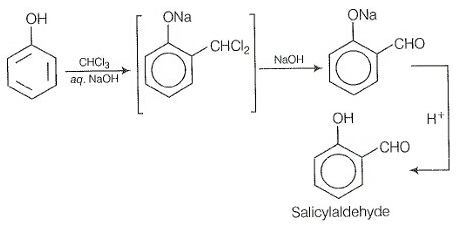Match the reactions from Column-I with their corresponding descriptions from Column-II and select the correct option.
|
Column-l (Name of Reaction) |
Column-ll (Description of Reaction) |
||
| A. |
Reimer-Tiemann reaction |
I. |
Conversion of phenol to o-hydroxysalicylic aid |
| B. |
Kolbe's reaction |
II. |
Heated copper at 573K |
| C. |
Conversion of 2alcohol to a ketone |
III. |
Reaction of an alkyl halide |
| D. |
Williamson's synthesis |
Iv. |
Conversion of phenol to salicylaldehyde |
Codes:
| A | B | C | D | |
| 1. | II | III | IV | I |
| 2. | III | IV | I | II |
| 3. | I | IV | III | II |
| 4. | IV | I | II | III |

B. In Kolbe’s reaction, 2-hydroxy benzoic acid (salicylic acid) is prepared by the reaction of phenol with gas.
![SOLVED] Explain Kolbe's reaction with an equation.](https://haygot.s3.amazonaws.com/questions/874724_947211_ans_bbef6485cb8f4971b1ab24b2dcaa7182.png)
C. When a 2° alcohol is allowed to pass overheated copper at 573 K, dehydrogenation takes place and a ketone is formed.
D. Williamson synthesis is an important method for the preparation of ethers. In this method, an alkyl halide is allowed to react with sodium alkoxide.
R—X +R—ONaROR + NaX

© 2025 GoodEd Technologies Pvt. Ltd.